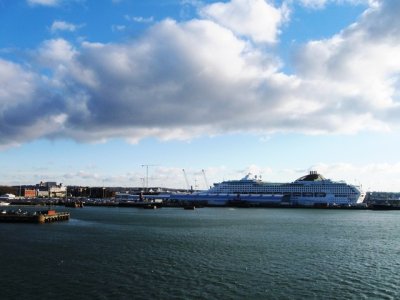Discover the ancient gateway that still whispers tales of the Titanic tragedy–you won’t believe what else it’s seen!
- Replies 0
Step into a portal of time where the echoes of the past blend with the pulse of the present. Southampton, a city with a history as rich as the soil upon which it stands, has been a silent witness to the comings and goings of history's most pivotal moments.
It's a place where the grandeur of the past meets the innovation of the future, and where the whispers of the Titanic still linger in the air.
Welcome to the ancient gateway that has seen the world unfold, and continues to watch history in the making.
For over two millennia, Southampton has been more than just a port; it's been a launchpad for dreams, a refuge for adventurers, and a crossroads for cultures.
From the early days of trading wool and spices to the dawn of the modern cruise industry, this city has been at the heart of maritime history.
In the early 20th century, Southampton was the glittering jewel in the crown of global travel. It was the place where the world's most luxurious ocean liners, such as the RMS Titanic, began their voyages across the Atlantic.
The city's name became synonymous with adventure and luxury, rubbing shoulders with the likes of New York and Sydney.

The city's residents, as JB Priestley observed in his 1934 travelogue “English Journey,” took great pride in their maritime heritage.
The arrival and departure of the great ships were not just events; they were spectacles that defined the city's rhythm and soul.
But Southampton's story is not without its shadows. The city has seen its share of tragedy and triumph. The Titanic, often dubbed the “Ship of Dreams,” is perhaps the most haunting legacy of all.
The disaster that befell this majestic liner on its maiden voyage from Southampton's docks has left an indelible mark on the city.
The SeaCity Museum's "Titanic Story" exhibition poignantly captures the local impact of the tragedy, with a city map dotted in red to show the widespread grief that touched hundreds of households.
Today, the city pays homage to its maritime history, with pubs like the White Star Tavern and the Grapes, which hold stories of passengers and crew who were part of the Titanic's fateful journey.
The city's streets and docks are a living museum, a testament to the lives that have passed through on their way to new horizons.
Southampton's maritime narrative continued to evolve with the rise of the ocean liner.

The city's strategic location and unique “double tide” made it an ideal hub for the burgeoning industry.
As competition for the fastest transatlantic crossing heated up, so did the luxury onboard these floating palaces. Lavish amenities and opulent decor became the norm, with Southampton at the center of this golden age of travel.
The city's docks expanded to accommodate the growing size and number of ships, and the port became a stage for grand departures and arrivals.
The Queen Mary's maiden voyage in 1936 was a spectacle that drew thousands to Southampton, eager to witness the grandeur of this new era of travel.
As the age of commercial aviation began to eclipse transatlantic liners, Southampton adapted once again, this time embracing the concept of cruising.
The city became a gateway for a new kind of maritime adventure, one that offered a series of destinations in a single voyage.
Today, Southampton remains a bustling cruise port, with passengers from all walks of life embarking on journeys to explore the world.
The city's docks are a microcosm of diversity, reflecting the changing face of travel and the enduring allure of the sea.
From the grandeur of Cunard's Queen Mary 2, reminiscent of the bygone era of ocean liners, to the modern party vibes of Virgin Voyages, Southampton continues to be a place where dreams set sail.
Yet, as the cruise industry thrives, it also faces new challenges. Issues of overtourism and environmental impact are at the forefront of the conversation.
Southampton, like the industry it supports, is seeking ways to balance growth with sustainability.
Initiatives like shore power aim to reduce the environmental footprint of these magnificent ships, but there is a recognition that more must be done to ensure the future of cruising is as bright as its past.
Southampton's legacy is not just in the ships that have come and gone but in the people who have stayed.

We invite you to share your thoughts and experiences of Southampton, the Titanic, or your own maritime adventures. Join the conversation and become a part of the rich tapestry that makes up this historic port city!
It's a place where the grandeur of the past meets the innovation of the future, and where the whispers of the Titanic still linger in the air.
Welcome to the ancient gateway that has seen the world unfold, and continues to watch history in the making.
For over two millennia, Southampton has been more than just a port; it's been a launchpad for dreams, a refuge for adventurers, and a crossroads for cultures.
From the early days of trading wool and spices to the dawn of the modern cruise industry, this city has been at the heart of maritime history.
In the early 20th century, Southampton was the glittering jewel in the crown of global travel. It was the place where the world's most luxurious ocean liners, such as the RMS Titanic, began their voyages across the Atlantic.
The city's name became synonymous with adventure and luxury, rubbing shoulders with the likes of New York and Sydney.

Southampton has been a significant port for 2,000 years, serving as a historic gateway to the world for explorers, traders and immigrants. Image source: Alex McGregor / Wikimedia Commons.
The city's residents, as JB Priestley observed in his 1934 travelogue “English Journey,” took great pride in their maritime heritage.
The arrival and departure of the great ships were not just events; they were spectacles that defined the city's rhythm and soul.
But Southampton's story is not without its shadows. The city has seen its share of tragedy and triumph. The Titanic, often dubbed the “Ship of Dreams,” is perhaps the most haunting legacy of all.
The disaster that befell this majestic liner on its maiden voyage from Southampton's docks has left an indelible mark on the city.
The SeaCity Museum's "Titanic Story" exhibition poignantly captures the local impact of the tragedy, with a city map dotted in red to show the widespread grief that touched hundreds of households.
Today, the city pays homage to its maritime history, with pubs like the White Star Tavern and the Grapes, which hold stories of passengers and crew who were part of the Titanic's fateful journey.
The city's streets and docks are a living museum, a testament to the lives that have passed through on their way to new horizons.
Southampton's maritime narrative continued to evolve with the rise of the ocean liner.

The city played a crucial role in the development of the modern cruise industry and was once home to the White Star Line, the company that owned the Titanic. Image source: Robert Welch / Wikimedia Commons.
The city's strategic location and unique “double tide” made it an ideal hub for the burgeoning industry.
As competition for the fastest transatlantic crossing heated up, so did the luxury onboard these floating palaces. Lavish amenities and opulent decor became the norm, with Southampton at the center of this golden age of travel.
The city's docks expanded to accommodate the growing size and number of ships, and the port became a stage for grand departures and arrivals.
The Queen Mary's maiden voyage in 1936 was a spectacle that drew thousands to Southampton, eager to witness the grandeur of this new era of travel.
As the age of commercial aviation began to eclipse transatlantic liners, Southampton adapted once again, this time embracing the concept of cruising.
The city became a gateway for a new kind of maritime adventure, one that offered a series of destinations in a single voyage.
Today, Southampton remains a bustling cruise port, with passengers from all walks of life embarking on journeys to explore the world.
The city's docks are a microcosm of diversity, reflecting the changing face of travel and the enduring allure of the sea.
From the grandeur of Cunard's Queen Mary 2, reminiscent of the bygone era of ocean liners, to the modern party vibes of Virgin Voyages, Southampton continues to be a place where dreams set sail.
Yet, as the cruise industry thrives, it also faces new challenges. Issues of overtourism and environmental impact are at the forefront of the conversation.
Southampton, like the industry it supports, is seeking ways to balance growth with sustainability.
Initiatives like shore power aim to reduce the environmental footprint of these magnificent ships, but there is a recognition that more must be done to ensure the future of cruising is as bright as its past.
Southampton's legacy is not just in the ships that have come and gone but in the people who have stayed.
Key Takeaways
- Southampton has been a significant port for 2,000 years, serving as a historic gateway to the world for explorers, traders and immigrants.
- The city played a crucial role in the development of the modern cruise industry and was once home to the White Star Line, the company that owned the Titanic.
- Southampton's shipping industry has been influenced by competition, maritime disasters and the evolution of ocean liners into luxurious floating palaces.
- Despite challenges like overtourism and environmental concerns, Southampton's port continues to serve as a critical link in the cruise industry, contributing to the city's multicultural community and history.
We invite you to share your thoughts and experiences of Southampton, the Titanic, or your own maritime adventures. Join the conversation and become a part of the rich tapestry that makes up this historic port city!






